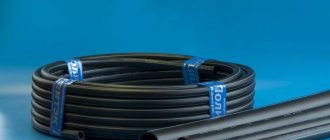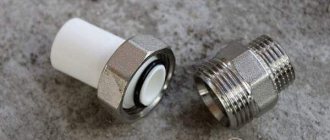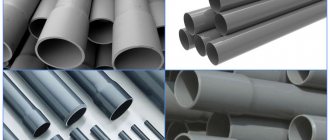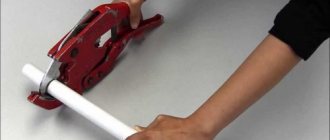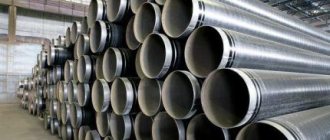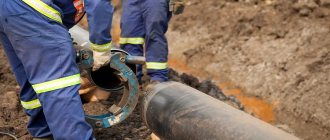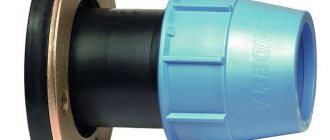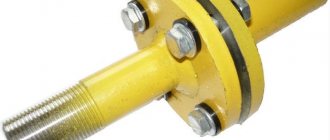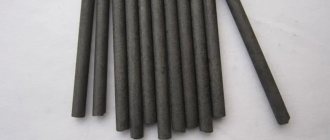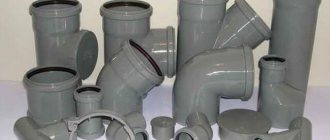New engineering systems are increasingly being created using pipe products made from polypropylene and low-density polyethylene. Often pipelines made of PP and HDPE have to be connected to each other. This makes it possible not to dismantle already laid communications made of low-density polyethylene.
Therefore, it will be useful to learn how to connect a HDPE pipe with a polypropylene pipe when upgrading and repairing an existing network. The information will be especially useful for beginning craftsmen.
What are HDPE pipes?
HDPE is produced by extrusion from polymerized ethylene. Finished products in the form of pipes are used for the construction of highways for the transportation of liquid and gaseous media. This can be natural fuel, drinking or industrial water, wastewater. The classification is also based on the permissible pressure inside the channels. High-pressure ones cope with 2.5 MPa, low-pressure ones with 0.6 MPa, non-pressure ones are designed for the installation of gravity wires.
The basic technical characteristics of HDPE pipes are as follows:
- the operating temperature range is presented as -20-+40 degrees Celsius;
- the maximum thermometer readings are +70 degrees Celsius;
- strength up to 38 MPa;
- pressure ranging from 6 to 25 Atm;
- diameter up to 120, less often up to 150 mm.
In addition to the construction of highways using HDPE products, protection devices for electrical wiring are allowed. The product lasts for about 50 years. On trading floors, pipes are presented in the form of coils of 100, 200 and 1000 m or sections of up to 12 m.
Coils and cut products from HDPE Source billionnews.ru
Advantages and operational features of HDPE pipes
The versatility regarding the use of HDPE pipes is explained by the tightness, elasticity and resistance of the material to aggressive operating conditions. The internal surface of the products is smooth, which virtually eliminates the risk of accumulation of sludge and deposits, ensuring efficient use of the wire throughout its entire service life.
Also, the advantages of such products include the following properties:
- corrosion resistance;
- inertness to the chemical environment;
- lightness (almost 6 times less than steel);
- plasticity (movement without depressurization is allowed by 5-7% of the initial position, which is important in case of freezing of transported liquids);
- resistance to water hammer;
- simplicity regarding installation and maintenance;
- low cost.
HDPE wire for drinking water Source otoplenin.ru
The material is environmentally friendly and allows for self-installation. But there are disadvantages that need to be considered before choosing. It is unacceptable to use HDPE pipes for heating equipment. To lay channels in the ground, its mobility must be taken into account. Ultraviolet radiation negatively affects the technical characteristics of the material.
Determination of Applicability
To simplify the selection of low-density polyethylene pipes, manufacturers mark the finished product and apply a color indicator. Thus, a yellow longitudinal stripe indicates the purpose for a gas pipeline, red and blue - for cold and hot water, respectively. Regarding the maximum pressure, the designations PE 63, PE 80 and PE 100 are applied. Underneath this lies 6.3, 8 and 10 MPa.
Marking on finished products Source dpm-system.ru
Another method (also indicated in the labeling) involves tracking the SDR indicator. This is a dimensional coefficient that hides the ratio of the cross-section to the wall thickness. It looks like this (SDR/pressure limit):
- For pressure main systems, gas pipelines and sewers, the following indicators are relevant: 6/25, 7.4/20, 9/16, 11/12.
- Irrigation installations and low-pressure water pipelines: 13.6/10, 17/8, 17.6/7.
- Water supply to low-rise buildings is provided by pipes with SDR 21 and a permissible pressure of 6 Atm.
For internal service of houses with drinking water and gravity sewerage systems, products with a size coefficient of 26, 33 or 41 are used. This corresponds to a pressure of 4 to 5 Atmospheres.
Types of docking
A popular method of producing modern tubular products is the use of styrene. The materials make it possible to produce durable pipelines that are resistant to aggressive environments.
Plastic water pipe
They are used when installing plumbing with hot and cold water. At the same time, there are several methods for joining plastic pipes.
PP pipelines
Pipeline polypropylene parts are connected to each other using soldering. In this case, the joined elements of the system are heated using special welding equipment. It is usually called soldering iron or iron.
PP parts are heated up to 260 degrees. Then one element is inserted into another. The welded area is fixed in a stationary position until the molten polymer cools.
Connection with other types of pipe products is carried out using special combined couplings. They are PP products, on one side of which a metal sleeve with external or internal thread is pressed.
The other end of the fitting looks like a polypropylene pipe. It is this part that is soldered to the PP pipe. The other side of the coupling allows you to make a threaded connection with a pipeline made of a different material or with plumbing fittings.
Fittings set
Manufacturers produce PP combined couplings with turnkey edges. Such fittings are first screwed or twisted into a pipeline made of another material, and then welded with a special soldering iron with a PP pipe.
American pipes are also used for joining dissimilar pipes. These are dismountable connecting elements with a union nut and sealing materials.
They are made only of metal with threads on both ends or have a polypropylene pipe on one side. American women take a drag with minimal effort.
HDPE pipelines
Pipe sections made of low-density polyethylene are connected by creating a weld or fittings. In the second case, the tightness of the joint depends on the quality of the connecting elements and compliance with the installation technology.
Installation of water supply
The weld is created using special equipment. Installation is carried out using an electric coupling or the “butt-to-butt” method. The use of welding implies the creation of a permanent connection.
To ensure that the joint can be disassembled if necessary, special sealed parts are used. These are inexpensive, reusable HDPE fittings. Their design contains a clamping nut, the degree of tightening of which determines the tightness of the connection.
Special fittings are also produced for connecting pipelines made of dissimilar materials. Such elements have a thread at one end, and the other side is a smooth HDPE pipe with a clamping nut.
There are other options for joining pipelines made of different materials. They will be described below.
Connection methods
How to connect HDPE pipes to each other - the answer is technology. Homogeneous pipes can be connected using fittings or a welding device. In both cases, the tightness is maintained, although in the case of additional parts, the result largely depends on the quality of the products and compliance with installation rules.
Welded joint
For permanent connection of polyethylene pipes, special equipment is required. The weld seam forms a continuous seam, but the device is expensive, which ultimately affects the cost of construction and repair of communications. It is also worth noting that it is impossible to reconnect in case of an error.
Weld on a highway Source www.gnb-teh.ru
This kind of installation is carried out in 2 ways: joint to joint or using an electric coupling. In the first case, the ends of the pipes are subject to melting. The second option involves the use of a polyethylene part with a built-in metal spiral. The latter is heated using electric current, which promotes the formation of a weld.
Detachable connection
A detachable connection implies the possibility of dismantling and reconnecting pipes without violating the integrity of the pipes or disassembling the entire pipeline. For the installation of HDPE pipes, special sealed fittings are used, which can be used repeatedly. The advantage of this method is that there is no need for special equipment and inexpensive couplings.
Tools
Ease of installation is a key advantage of polypropylene. You will need certain materials and special tools:
- polypropylene pipes;
- pencil;
- clips to fix the line;
- roulette;
- couplings for connection;
- corners;
- Ushastik-MRV. It is used to secure the mixer;
- MVR outlets with metal threads;
- soldering device;
- scissors for plastic items.
Video description
The video shows how to assemble a HDPE fitting:
See also: Catalog of companies that specialize in engineering systems
This method is recommended for installing channels that are not subject to high pressure. Connections can also be realized in two ways: Compression fittings are sufficiently firmly secured. A socket assembly is rarely installed, as it has a relatively weak seal. Installation involves inserting one pipe into another and placing a sealing rubber gasket between them.
Socket connection of pipes Source www.kozansutesisatcisi.com
Fitting
Depending on the design, fittings can be used as connecting parts in a straight section, branched and rotary. Adapter options regarding pipe diameters and dissimilar materials are also considered. A separate type are plugs.
Connecting HDPE pipes with fittings is carried out in 4 steps:
- choosing a coupling in accordance with the diameter and depth of immersion of the pipe into it;
- ensuring maximum glide using a soap solution;
- unscrewing the nut and inserting the pipe to the desired limit.
The final step is to fix the products. To do this, tighten the clamping nut all the way. The level of tightness of the node connection depends on the degree of tightening.
Fittings for pipeline installation Source the-master.ru
Types of fittings
It is possible to connect 2 pieces of different materials using special fittings. They are also used when you need to connect plumbing fixtures to steel fittings. Inserts on fittings are necessary for a strong connection. They can be made of brass or chrome. Today the most common options are:
- crosses;
- combined tees;
- coupling;
- Ball Valves;
- adapters (have an external plastic thread).
Advice from experienced specialists
The ellipticity of the material can negatively affect the tightness. In this case, the seams will be of poor quality. If the contact is made by welding, then it is important to monitor the immobility of the pipes until the materials completely harden.
Equipment for welding seam Source i.ytimg.com
The ends of the products to be joined must be prepared in advance. This means removing dirt and dust. Additionally, you need to treat the surface with a degreaser.
If fittings with clamping nuts are used, it is important to tighten them to the limit, but not significantly. Excessive force may cause the element to burst. And the collet in this case is capable of crushing the end part of the pipe.
Using flanges
This connection is made using adapter bushings welded to the ends, or slip-on steel flanges (profiled and smooth) with threads on one side. They are installed without welding. Among the advantages, the high reliability of the joints is noted, withstanding high temperatures and pressures of up to 16 atm. The connection can be made on pipelines of different diameters from 2 to 120 cm.
Docking begins by pulling the flange onto the pipe and putting on the rubber gasket. It is installed at a distance of no more than 10 mm from the end. The flange is moved towards the gasket, and another pipe is prepared in the same way. The bolts are tightened carefully so as not to crack the plastic.
Connecting elements
The connection of structures made of metal-plastic or polypropylene is made using special fittings. These are connecting elements that allow you to install a water supply network of any design. There are different types of fittings. Among them there are dismountable threaded, press fittings and compression connectors. These two types of fittings are dismountable, so if a leak occurs at the connection point, you can replace the faulty element without any problems.
Press fittings are considered the most durable. However, if a leak occurs, replacing such a unit will cause some inconvenience. Installation of such parts is carried out using a special crimping coupling or press pliers.
Threaded fittings are mainly used for attaching a metal pipe to a metal-plastic one.
Properties and places of application of polypropylene
Two filters for cleaning. Self-washing and polypropylene thread
An important positive property of such a material is that corrosion processes have virtually no effect on the material. Low cost allows the use of polypropylene structures everywhere, and the ability to maintain tightness and integrity at a pressure of more than 20 bar makes it possible to use the material for water supply and heating in multi-story buildings. It is also worth noting the light weight and ease of installation. However, to solder homogeneous pipes you will have to acquire a special soldering iron. Thanks to the properties of the PPR material, the pipes are absolutely safe for health, hygienic and can last up to 100 years.
Pipes are available in a variety of colors, but the most common color is white. Of the entire color range, only black pipes have a special layer of protection against ultraviolet rays, which allows them to be used for a long time in the open sun.
To create a water supply system for an apartment building, material with a diameter of 16 mm or more is used. For the use of cold water communications, one-piece pipes work well. For hot water, it is recommended to use PPR material with a foil insert. Foil-lined pipes compensate for expansion due to heating and are marked with the designation PPR. But foil pipes are already considered metal-polymer.
Fitting into socket
In this way, sewer systems are assembled from polypropylene and PVC pipes, one end of which is made in the form of a socket. The use of this connection reduces installation time and is cheaper, since there is no need for additional connecting elements. The assembly of pipelines using this technology can be carried out by any beginner independently.
Before joining, you need to make sure that the end without a socket is perpendicular to the axis, otherwise the pipeline may bend during operation. The edge is chamfered with a file so as not to damage the rubber sealing ring in the socket. It is cleaned of dirt and dust. To achieve increased sealing, the prepared end of the pipe is lubricated with silicone grease, then inserted into the socket until it stops. At the place where its edge stopped, a mark is placed and moved back 1 cm. The resulting gap is necessary to compensate for the linear expansion that occurs during heating.
